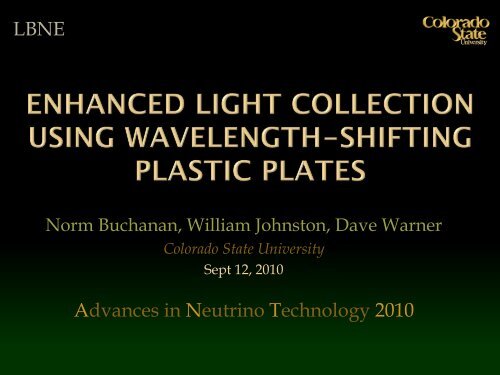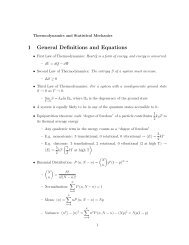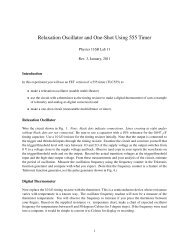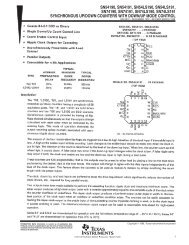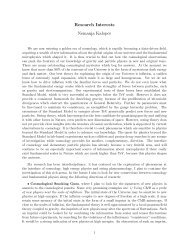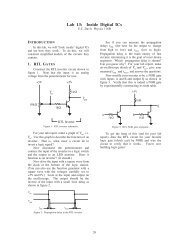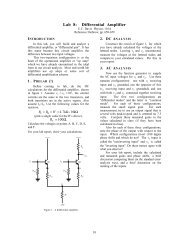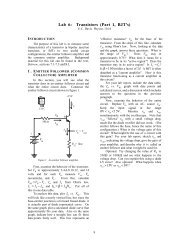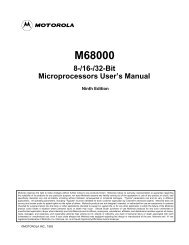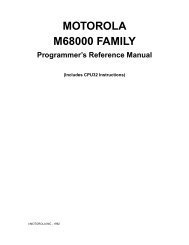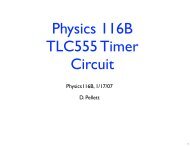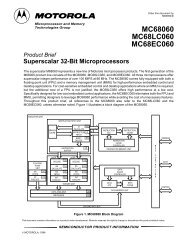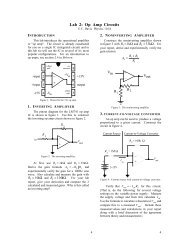WLS Light Collectors - UC Davis
WLS Light Collectors - UC Davis
WLS Light Collectors - UC Davis
Create successful ePaper yourself
Turn your PDF publications into a flip-book with our unique Google optimized e-Paper software.
LBNE<br />
Norm Buchanan, William Johnston, Dave Warner<br />
Colorado State University<br />
Sept 12, 2010<br />
Advances in Neutrino Technology 2010
• PMTs significant portion of WCD cost<br />
• PMT (+Base) cost (estimate): off the shelf cost ~$4200<br />
• Additional casts for cabling and mounting<br />
Geometry<br />
Fiducial Vol.<br />
(kT)<br />
Coverage<br />
(%)<br />
# PMTs Off shelf Cost<br />
(M$)<br />
25% reduced<br />
cost (M$)<br />
50% reduced<br />
cost (M$)<br />
Right cylinder 100 20 57,129 239.9 179.9 120.0<br />
Right cylinder 150 20 73,012 306.7 230.0 153.4<br />
Right cylinder 200 (2 x 100) 20 114,258 479.9 359.9 240.0<br />
Mailbox 150 20 84,466 354.8 266.1 177.4<br />
Eg. LBNE far detector with 20% coverage. PMT numbers (not costs) taken from John Felde (<strong>UC</strong> <strong>Davis</strong>) for LBNE far<br />
detector simulation<br />
• Even 10% less PMTs leads to significant cost reduction.<br />
• Improved light collection efficiency is potential solution<br />
• Reflective cones (used in SNO)<br />
• WS plates (explored for IMB)<br />
• WS PMT coatings<br />
• Combination (plates or cones with WS coating)<br />
2
• Explored for IMB<br />
• Square plates were pressure fit to the PMT<br />
• Demonstrated improvement (doubling) in collection efficiency<br />
5”<br />
60 cm (~24”)<br />
R. Claus et al, Nucl. Inst. and Meth. A261 pp. 540-542 (1987)<br />
• Improvements in design to be made<br />
• Circular geometry (20” outer radii prototypes)<br />
• Index matched RTV between plate and PMT<br />
• Tyvek with black backing on plate back.<br />
• Idea is to diffuse the light back into the plate and prevent escape through back<br />
3
• 1 approach being studied (others discussed at this meeting)<br />
• Plan is to have baseline result by Oct 1, 2010<br />
• demonstrate increase in efficiency warrants further study<br />
• if potential to improve efficiency further studies undertaken<br />
• Potential benefits of WS plate<br />
• Relatively cheap and easy to manufacture<br />
• Efficiency increase scales with plate size<br />
• Base plastics well understood - polyvinyl toluene (PVT)<br />
• Minimal blocking of PMT cathode (depends on plate backing)<br />
• Potential issues of WS plate<br />
• Difficult to simulate (WS plastic absorption and re-emission)<br />
• Reflections back into vessel volume<br />
• Degradation of physics (smeared out timing)<br />
• Increased dark rates<br />
• Effect on WS plastic by backgrounds (uranium and thorium)<br />
• Cosmic hits in plates<br />
4
• Build and Test Prototype<br />
• Prepare test facility<br />
• Acquire 10” HQE PMT<br />
• Basic characterization of PMT (dark rates, gain, etc…)<br />
• Acrylic prototype<br />
• WS plastic prototypes (expect delivery week of Sept 20 th )<br />
• Measured LC efficiency, dark rates, timing degradation<br />
• Personnel and facilities<br />
• Buchanan (faculty – planning and management): started @ CSU July 1, 2010<br />
• Warner (engineer – design , much experience with plastics, RTV, etc…)<br />
• Johnston (student – data collection, test setup, analysis)<br />
• Technicians (senior + temp – mechanical and assembly work)<br />
• Machine shop ( + Machinist – capable of all machining needs)<br />
• Simulations<br />
• Due to short timeline no simulations before October<br />
• Single device and full detector simulation after empirical measurement<br />
5
• Needed dark “room” large enough for water tank<br />
• added large cabinet to small existing lab space<br />
• 3 separate dark spaces – allows source in different location, but close by<br />
• feed-throughs for electrical signals, power, and optics<br />
#1<br />
#3<br />
#2<br />
#1 #2<br />
3 isolated chambers<br />
#3<br />
Feed-throughs<br />
Also optical feed-through<br />
between chambers 1 and 2<br />
6
DAQ room<br />
SRS pulser<br />
0.5 m fiber<br />
splitter<br />
LED<br />
LC plate<br />
10” PMT<br />
5.5 m fiber<br />
diffuser<br />
Reference PMT<br />
5.5 m fiber<br />
Chamber #1<br />
Chamber #2<br />
7
• Use LED as light source<br />
• 405 nm LED provide Cerenkov-like photons<br />
• adjusted to give ~20 photons/integration gate<br />
• Low tech – black plastic 55 gal. drum<br />
• cut top off to hang PMT/plate from<br />
• fiber runs to bottom and into quartz light diffuser<br />
• 2 nd PMT used as reference<br />
• time reference for time degradation measurements<br />
• allows cancellation of LED fluctuations<br />
8
• Using a Hamamatsu HQE 10” R7081 PMT<br />
• On loan from UPenn – slight chance they may get a working unit back<br />
• Attached a collar to allow safe handling and mounting for tests<br />
Characteristics<br />
• Gain ~10 7 at 1585 V bias<br />
• Dark rate: ~4kHz after 24 hours in dark<br />
Adjustable collar with foam<br />
interface between plastic and PMT<br />
Notched “arms” for supporting<br />
PMT and LC plate in water tank<br />
9
• WS plastic delivery delayed until around Sept 20 th<br />
• Use acrylic as a first prototype<br />
• Work through mechanical details<br />
• Test RTV bond of Tyvek to plate<br />
• Dry run of full readout and analysis<br />
RTVing Tyvek to plate<br />
(using RTV6136 (1:1) mix – cured for >4 hrs)<br />
PMT area: 78.5 in 2<br />
Plate area: 235.6 in 2<br />
Tyvek attached<br />
Tyvek has black backing (used<br />
for Auger water bladders)<br />
10
Test fit (no Tyvek) Leveling LV plate on PMT Injecting RTV into air gap<br />
Injecting RTV into air gap<br />
LC prototype with Tyvek backing mounted on PMT<br />
11
• 2 WS plastic prototypes<br />
• blue-green to couple directly to PMT<br />
• blue-blue to couple to WS coating on PMT (also shorter decay time)<br />
• WS plastics same base as used in scintillator plastics<br />
• Polyvinyl toluene (PVT)<br />
• slightly softer than acrylic - requires slightly slower machining<br />
• BC-499-76 (blue-blue) has short decay time (2.1 ns)<br />
• replaces BC-480<br />
• better match to potential WS film coatings on PMT?<br />
• BC-482A (blue-green) slightly longer decay (12 ns)<br />
• better match to PMT without coating<br />
WS Plastic Vendor Type Base Index of<br />
Refraction<br />
BC-499-76 Saint-Gobain Blue - Blue PVT 1.58 2.1 ns<br />
BC-482A Saint-Gobain Blue - Green PVT 1.58 12 ns<br />
Decay Time<br />
Some specifications of test WS plastics<br />
12
PMT Only for all plots<br />
• Testing acrylic prototype in air<br />
• nailing down technique and analysis<br />
• want to minimize activity that might stress PMT<br />
• Using 2 nd PMT to monitor LED and provide t 0 for timing studies<br />
• perform event-by-event subtraction to remove LED fluctuations<br />
• 2 DAQ settings for slow (raw) and fast (pre-histogrammed) collection<br />
Reference PMT<br />
Reference PMT<br />
ADC bin (arb units)<br />
10” Test PMT<br />
10” Test PMT<br />
ADC bin (arb units)<br />
Pedestals for both PMTs at operating settings<br />
Flashed LED for both PMTs at operating settings<br />
13
• Dark rate<br />
• initial dark noise rate higher with disk attached<br />
• after 24 hours in dark box rates with and without disk were the same<br />
WS disk attached Initial dark rate Dark rate after 24 hours<br />
No 40 kHz 4 kHz<br />
Yes 120 kHz 4 kHz<br />
• <strong>Light</strong> Collection Efficiency<br />
• No measureable increase (or change) in ADC spectrum when plate attached<br />
• Not unexpected as acrylic not “active” …but see below<br />
• Cross-checks to be performed<br />
• Use photo-sensor (Hamamatsu MPPC) to map photon distribution at tank top<br />
• Remove RTV between plate and Tyvek<br />
• RTV at interface might be changing Tyvek diffusion properties<br />
14
BC-499-76 Tyvek+RTV Misc costs (setup,<br />
mounting, etc…)<br />
Total unit cost<br />
$225/unit $2/unit ~$70/unit ~$300<br />
• Estimate for plastic based on 25 sheet run (2’ x 4’)<br />
• presumably we could negotiate lower cost for much larger run<br />
• Technical support contact at S-G claims large production OK<br />
• can produce 700 kg to 1000 kg per week (~250 – 350 plates/week or 3 years production)<br />
• can produce sheets 32” x 100” sheets – >1 cast in parallel<br />
• production has to be worked in with existing orders<br />
• have not talked with other vendors (eg. Eljen Tech.)<br />
15
• Simulations<br />
• need significant simulation at device and detector level<br />
• will aid in paring down my crazy ideas<br />
• use Geant4 with visible photon package<br />
• need 50% of student for this work over next year<br />
• Improve test facility to use cosmics<br />
• Would like to use actual Cerenkov light<br />
• Bigger test tank?<br />
• Reflection measurements (need large tank)<br />
• 3m x 3m x 1m tank at <strong>UC</strong> <strong>Davis</strong><br />
• build something local?<br />
• More sophisticated prototypes<br />
• <strong>Light</strong> guiding (graded index planes or air bubble injection)<br />
• WS layer on acrylic substrate (potentially significant cost reduction)<br />
• Plate shaping (assumes good light guiding properties)<br />
• Backing materials (Tyvek, other diffusers – ground surface)<br />
• Fabrication and mounting<br />
16
PMT<br />
PMT<br />
• Want to get light in the collector to the PMT<br />
• reflections from either surface of the plate can impact physics<br />
• getting as much light as possible to the PMT improves efficiency<br />
• Playing games with diffusers on back of plate may help<br />
• allow some light back into plate while minimizing reflections<br />
• Graded index laminate on the plate<br />
Graded index laminate<br />
WS plate<br />
Decreasing N<br />
Diffusion layer<br />
• use like light guide – graded index prevents reflection boundaries<br />
• need to be careful of increasing front face reflections<br />
18
PMT<br />
• Potential to reduce costs with less WS plastic<br />
• use thinner WS plastic layer bonded to acrylic substrate<br />
• increase plate area, adjust fluorescent dopant<br />
• need to determine change in light absorption<br />
• can a WS film be effective on an acrylic plate?<br />
• Collection of light from WS layer critical<br />
• might need to employ light guiding tecniques<br />
• graded index plates on front side of WS layer<br />
• diffuser on back side of acrylic<br />
WS plastic layer<br />
Acrylic plate<br />
Diffusion layer<br />
19
• Contamination<br />
• ultra-pure water requires hard limits on contaminants<br />
• all proposed materials will be heavily scrutinized<br />
• WS plastic bases well known – glues/RTVs will be challenging<br />
• Pressure and Implosion Cascades<br />
• shockwave from implosion can be in the MPa range<br />
• care must be taken when planning attachment of plate to PMT<br />
• can plate come into ANY contact with PMT glass?<br />
• Impact on Physics<br />
• this cannot be emphasized enough<br />
• Gain in LC efficiency wasted if physics capabilities degraded!<br />
• Much work to be done to make sure this isn’t the case (for all<br />
approaches to improving light collection efficiency)<br />
20
• Improving light collection for PMTs can lead to<br />
significant cost savings<br />
• Currently studying WS LC plates for potential use in<br />
LBNE<br />
• Results from acrylic show no measureable enhancement<br />
• On track to have results for WS prototypes by end of Sept.<br />
• Motivation to look into additional enhancements to WS<br />
plates<br />
• <strong>Light</strong> guiding with graded index layers on front face of LC<br />
• Explore use of thin WS plastics on acrylic substrates<br />
• Need to ensure physics potential of detector not significantly<br />
impacted<br />
21


